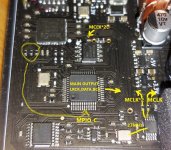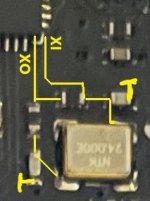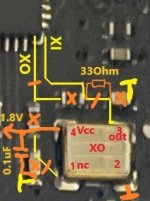Could not resist ordering this dac, sadly... 🙂
Do you guys think changing the value vref 2200uf caps by a factor of say 2 may introduce power up/down problems?
Vref seemms to be a critical part according to datasheet, and i doubt the rubycons are really of high manufacture quality, though i don't expect esoteric parts. Sometimes also some less costly solutions just sounds more ''right''.
Do you guys think changing the value vref 2200uf caps by a factor of say 2 may introduce power up/down problems?
Vref seemms to be a critical part according to datasheet, and i doubt the rubycons are really of high manufacture quality, though i don't expect esoteric parts. Sometimes also some less costly solutions just sounds more ''right''.
AFAIK they are datasheet values. I just changed them for others as I had them. Some claim that 2200 uF is too much so AKM don’t seem to know their own chips. They sure don’t need to be any higher in value. Maybe you will indeed introduce ramp up issues. That is up to you to try out. In 1 case with such large caps but no series resistors I suspected this to be the cause of a defective DAC chip (other device). Probably the caps discharge in the IC at power off and are the datasheet 10 Ohm resistors possibly also meant for current limiting. Just be informed that the PCB material in question is not suitable for reworking.
In hindsight the power supply scheme is according the sales price of the device. High risk endeavours but doable if you are experienced. Keep connections short. As I got information in incomplete/scattered form I haven’t taken the opportunity (yet) to work on that except cutting buspower en adding a very low noise linear PSU.
There is nothing wrong with Rubycon as a brand (we can not be too critical on the manufacturer of Black Gate caps can we? 😉). Maybe you can look up the series and see the properties for judgment.
Please know that a at least a few of such claims are exxagerated and practically undetectable by ear. This can be proven by letting the SU-1 burn in and then listening to it. Is it so so, good or very good?
In hindsight the power supply scheme is according the sales price of the device. High risk endeavours but doable if you are experienced. Keep connections short. As I got information in incomplete/scattered form I haven’t taken the opportunity (yet) to work on that except cutting buspower en adding a very low noise linear PSU.
There is nothing wrong with Rubycon as a brand (we can not be too critical on the manufacturer of Black Gate caps can we? 😉). Maybe you can look up the series and see the properties for judgment.
Please know that a at least a few of such claims are exxagerated and practically undetectable by ear. This can be proven by letting the SU-1 burn in and then listening to it. Is it so so, good or very good?
Last edited:
Yes i will look up what they are exactly. So far by experience, i see that brand mostly in ''cheaper'' products. I had only one cap buldging in a computer psu and it was a rubycon. But i am careful not to draw conclusions or go nuts about branding. Anyway, still it is a 79$ dac, so it is not completely out of question that they wanted to cut costs somewhere too.
Anyway, what about the pcb? are the traces detaching easily?
Anyway, what about the pcb? are the traces detaching easily?
I does not ;-) not on mine anyway...Do you guys think changing the value vref 2200uf caps by a factor of say 2 may introduce power up/down problems?
//
TNT, can you share more detail on that? Personally, i'm planning to try 1000uF nichicon KZ.
But if 2200uF was chosen by default bu SMSl, chances are larger capacity brings subjective sonic benefits and was chosen after A/B testing by the company, because one may think that such a large capacitor in a dac is just overkill. unless it is part of an rc filter?
But if 2200uF was chosen by default bu SMSl, chances are larger capacity brings subjective sonic benefits and was chosen after A/B testing by the company, because one may think that such a large capacitor in a dac is just overkill. unless it is part of an rc filter?
Is it possible to summarise which modifications can be used to improve the SMSL-SU1?
Does each circuit really have to have its own dedicated current source or are the built-in DC converters sufficient in terms of low noise?
Is there any benefit in increasing the capacity of the electrolytic capacitors? We should not forget that the SU-1 measures really well out of the box.
https://www.audiosciencereview.com/forum/index.php?threads/smsl-su-1-stereo-dac-review.44029/
Does each circuit really have to have its own dedicated current source or are the built-in DC converters sufficient in terms of low noise?
Is there any benefit in increasing the capacity of the electrolytic capacitors? We should not forget that the SU-1 measures really well out of the box.
https://www.audiosciencereview.com/forum/index.php?threads/smsl-su-1-stereo-dac-review.44029/
I found that the all data from XMOS goes to the input C of the transceiver, then goes to the DAC from the main output of the transceiver, and the DAC MCLK input is connected to an unknown IC in soic-10(?) case. This IC works on active 27Mhz crystal and makes master clock and also doubled MCLK for XMOS. By the way, the rest of crystals are passive, so the main improvement for USB users will be upgrade this 27Mhz and XMOS 24Mhz crystals. 24.576Mhz near transceiver is needed only for SPDIFMe too...
Attachments
Last edited:
and the DAC MCLK input is connected to an unknown IC in soic-10(?) case.
Maybe this is PLL-chip, providing audio clock frequencies (44.1x/48x) from 27MHz OSC.
I'm personally prefer to use 2 separate oscillators with audio frequencies.
Alex.
I think using LT3042 and similar LDOs in digital circuits is complete overkill.
And here it is a difference even between regulators at PLL_AVDD.
Both powered by main linear supply with TPS7A4701, in both cases RC 4.7R+10uF are present at PLL_AVDD. In first case 1V for core and PLL_AVDD is made by 1117-3.3V > AP7365-10YG-13, in second by LT3045.
Both powered by main linear supply with TPS7A4701, in both cases RC 4.7R+10uF are present at PLL_AVDD. In first case 1V for core and PLL_AVDD is made by 1117-3.3V > AP7365-10YG-13, in second by LT3045.
You can do whatever you want.
But as for me, more than 12 years, since I started to play with XMOS CPUs, I use 1117-3.3 and 1117-1.8 or LM3671 for digital power and AP7365 or TPS72010 for the core power (1.0v), with TPS3106K33 supervisor.
And had no problem yet.
Alex.
But as for me, more than 12 years, since I started to play with XMOS CPUs, I use 1117-3.3 and 1117-1.8 or LM3671 for digital power and AP7365 or TPS72010 for the core power (1.0v), with TPS3106K33 supervisor.
And had no problem yet.
Alex.
Why is this discussion in this thread?
1117 regulators do not cause problems (which ones do except those by ESS?) but they are not the best of choices either. I use the AMS1117 versions with pleasure though.
Whatever the discussion is, trying to prove the opposite by stating that there are no problems is weak reasoning. Using the best design PSU by yourself also will not cause problems is it? So from lowest to highest quality there will hardly be problems. I think the nuance is meant, having better stuff in the details will subjectively cause improvements. In analog this is clear but in digital not so IMHO but it keeps some busy.
1117 regulators do not cause problems (which ones do except those by ESS?) but they are not the best of choices either. I use the AMS1117 versions with pleasure though.
Whatever the discussion is, trying to prove the opposite by stating that there are no problems is weak reasoning. Using the best design PSU by yourself also will not cause problems is it? So from lowest to highest quality there will hardly be problems. I think the nuance is meant, having better stuff in the details will subjectively cause improvements. In analog this is clear but in digital not so IMHO but it keeps some busy.
Last edited:
SPDIF users don't read this, any changes around XMOS affects only about USB connection type.
Because this (about power supply and clock) belongs to all XMOS. Here you can listen (please don't flood that topic, I just show another XMOS owner device about processor clock affects and there are examples with attributions) how XMOS clock affects on sound (even with swapping XO with XO on another XMOS board). The effect with swapping XTAL with XO in SMSL is the same. And here is example how to make it. Don't do it if you don't understand what exactly you do in schematic at the board. XU316 accept 1.8V level at XI, so you need to make 1.8V low noise power supply for XO (I reccomend Kyocera K series). Don't put 1.8V from regulators near USB connector, it is noisy DC-DC switcher. Another way without adding 1.8V LDO is to change AKM supply voltages to 1.8V with disabling internal LDO, about it here and put it for XO from AKMs DVDD.
https://www.digikey.com/en/products/detail/kyocera-avx/KC2520K24-0000C1GE00/5322481
Because this (about power supply and clock) belongs to all XMOS. Here you can listen (please don't flood that topic, I just show another XMOS owner device about processor clock affects and there are examples with attributions) how XMOS clock affects on sound (even with swapping XO with XO on another XMOS board). The effect with swapping XTAL with XO in SMSL is the same. And here is example how to make it. Don't do it if you don't understand what exactly you do in schematic at the board. XU316 accept 1.8V level at XI, so you need to make 1.8V low noise power supply for XO (I reccomend Kyocera K series). Don't put 1.8V from regulators near USB connector, it is noisy DC-DC switcher. Another way without adding 1.8V LDO is to change AKM supply voltages to 1.8V with disabling internal LDO, about it here and put it for XO from AKMs DVDD.
https://www.digikey.com/en/products/detail/kyocera-avx/KC2520K24-0000C1GE00/5322481
Attachments
Last edited:
- Home
- Source & Line
- Digital Line Level
- SMSL SU-1 design idea


